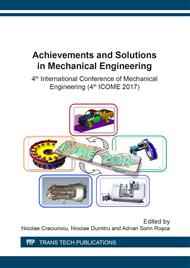[1]
Alexandru, P., Macaveiu, D., Alexandru, C., A gear with translational wheel for a variable transmission ratio and applications to steering box, Mechanism and Machine Theory, 52 (2012) 267-276.
DOI: 10.1016/j.mechmachtheory.2012.02.005
Google Scholar
[2]
Alexandru, P., Alexandru, C., Correlating requirements regarding the command and the mechanical structure of the automotive steering system, 10th IFToMM International Symposium, 2009, pp.217-226.
DOI: 10.1007/978-90-481-3522-6_17
Google Scholar
[3]
Sharp, R.S., Driver steering control and a new perspective on car handling qualities, Proceedings of the Institution of Mechanical Engineers - Part C, 219 (2005) 1041-1051.
DOI: 10.1243/095440605x31896
Google Scholar
[4]
Cho, Y.H., Kim, J., Design of optimal four-wheel steering system, Vehicle System Dynamics, 24 (1995) 661-682.
DOI: 10.1080/00423119508969112
Google Scholar
[5]
Sano, S., Furukawa, Y., Nihei, T., Abe, M., Handling characteristics of steer angle dependent four wheel steering system, SAE Technical Paper 885034 (1988).
DOI: 10.4271/885034
Google Scholar
[6]
Berkefeld, V., Seifert, G., Four wheel steering - handling and disturbance compensation on surface with various friction conditions, 24th FISITA World Congress, 1992, pp.87-94.
Google Scholar
[7]
Simionescu, P.A., Tempea, I., Loch, N.E., Kinematic analysis of a two-degree-of-freedom steering mechanism used in rigid-axle vehicles, Proceedings of the Institution of Mechanical Engineers - Part D 215 (2001) 803-812.
DOI: 10.1243/0954407011528392
Google Scholar
[8]
Qin, D., Chen, L., Zhong, Y., Pan, X., Setting-up and simulation of SUV full vehicle handling stability based on multibody dynamics, IEEE International Conference on Mechatronics and Automation - ICMA, 2007, pp.2683-268.
DOI: 10.1109/icma.2007.4303981
Google Scholar
[9]
Topping, R., Understeer concepts with extensions to four-wheel steer, active steer, and time transients, SAE International Journal of Passenger Cars - Mechanical Systems, 5 (2012) 167-186.
DOI: 10.4271/2012-01-0245
Google Scholar
[10]
Alexandru, C., Alexandru, P., The virtual prototype of a mechatronic suspension system with active force control, WSEAS Transactions on Systems, 9 (2010) 927-936.
Google Scholar
[11]
Tarniţă, D., Marghitu, D., Analysis of a hand arm system, Robotics and Computer-Integrated Manufacturing, 29 (2013) 493-501.
DOI: 10.1016/j.rcim.2013.06.001
Google Scholar
[12]
Tarniţă, D., Catană, M., Tarniţă, D.N., Contributions on the modeling and simulation of the human knee joint with applications to the robotic structures, Mechanisms and Machine Science, 20 (2014) 283-297.
Google Scholar
[13]
Alexandru, P., Visa, I., Alexandru, C., Modeling the angular capability of the ball joints in a complex mechanism with two degrees of mobility, Applied Mathematical Modelling, 38 (2014) 5456-5470.
DOI: 10.1016/j.apm.2014.04.032
Google Scholar


